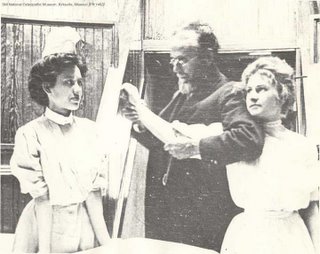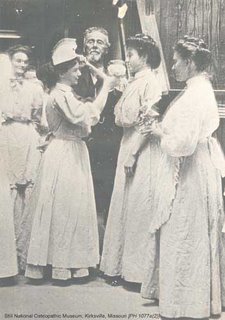What is it like to get an osteopathic manipulative treatment?
Source: www.andrewtaylorstill.com/omm.htm
 For a runner who is experiencing foot pain following routine training, OMM could be very appropriate. A D.O. would begin by examining your foot and by comparing the painful foot with the non-painful foot. The D.O. would identify the various bumps and grooves in the bones of the foot, that are common to all people, via palpation or touch. The D.O. would most likely also examine the Knee, and your lower back as well as the foot. After thoroughly explaining their findings to you, the D.O. would then begin the treatment. This treatment could consist of turning your foot in such a way as to allow a particular bone of the foot to be pushed back into it's proper position to relieve nerves, or could consist of a similar technique performed at the back or knee. In explaining how a disorder of the lower back would result in foot pain it was Dr. Still who said it best by saying "If your foot stepped on a cat's tail, you would hear the noise at the other end of the cat, wouldn't you?" However it is the simple relocation of the bone or other body structure (such as muscle or fascia) by the physician's hands that is formally referred to as OMM.
For a runner who is experiencing foot pain following routine training, OMM could be very appropriate. A D.O. would begin by examining your foot and by comparing the painful foot with the non-painful foot. The D.O. would identify the various bumps and grooves in the bones of the foot, that are common to all people, via palpation or touch. The D.O. would most likely also examine the Knee, and your lower back as well as the foot. After thoroughly explaining their findings to you, the D.O. would then begin the treatment. This treatment could consist of turning your foot in such a way as to allow a particular bone of the foot to be pushed back into it's proper position to relieve nerves, or could consist of a similar technique performed at the back or knee. In explaining how a disorder of the lower back would result in foot pain it was Dr. Still who said it best by saying "If your foot stepped on a cat's tail, you would hear the noise at the other end of the cat, wouldn't you?" However it is the simple relocation of the bone or other body structure (such as muscle or fascia) by the physician's hands that is formally referred to as OMM.How does OMM work?
The structures that you can feel within beneath your skin are not just limited to bone and muscle however, as there are several thick fibrous sheets of soft connective tissue that basically keep your body parts from traveling around like toys in a big bathtub. (If you have ever wondered why your veins, arteries, and nerves of your shoulder never fell down into your abdomen...it is partly because of these sheets of tissue formally called fascia) Interestingly enough, these sheets of connective tissue can in many cases toughen limiting circulation and irritating nerves.
There are many disorders that are the result of a lack of circulation and local nerve irritation. Your circulation plays a greater role in muscular pain than one might normally believe. Pain in many cases is the result of chemicals released in the body following injury. These chemicals travel via your circulatory system and thus any change in flow of that system can result in a delay in the removal of those chemicals. Persistent pain can be the result of this decrease in circulation...and thus often any procedure that increases local circulation (like removing the "kink in the hose" of the artery or vein) will reduce the pain. Restoring local circulation is one area in which OMM has had much success.

Lower back pain is very common complaint of many patients and can be the result of local nerve irritation. The problem itself can be very complicated, but simply put it is basically a matter of space within your body. Which is to say that there is limited space within your body and that movement of the intricate arrangement of parts within your back can cause direct contact with those parts and the complex network of nerves that radiate down into the legs from the spinal column. This direct contact of any body part with these nerves caused pain and can result in painful spasms that last for hours or even days. OMM consists of placing these body parts back into their original place so that the pressure on those nerves can be relieved reducing spasm and correcting the problem. In this oversimplified example, OMM can quickly resolve a problem that would ordinarily be treated with a $1,000 MRI and some pain killers. Again it is important to emphasize that today the osteopathic manipulative technique exists only to augment and not to replace modern medical therapies.
OMM therefore is most simply described as identifying and correcting the day to day shifts in position of our body parts that can cause symptoms such as pain. These changes in position can be the result of trauma as well, such as from a fall or from a collision. It is also important to note that pain is not the only symptom that can result from nerve irritation as there are nerves that carry the other sensations, such as nausea, that can be irritated anywhere along the path that the nerve travels within the body up to the central nervous system. (The various nerve sensations and how they are influenced is currently being researched by scientists and osteopathic physicians alike) These structural abnormalities are then corrected via simple massage, touch, and other release techniques all aimed at restoring normal motion and position.
0 Comments:
Post a Comment
<< Home